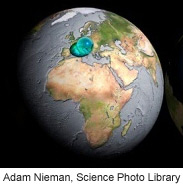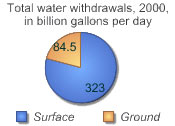 As you know, the Earth is a watery place, even if all of Earth's surface, ground, and atmospheric water would fill a sphere only about 1,400 kilometers across. About 70 percent of the Earth's surface is water-covered. But water also exists in the air as water vapor and in the ground as soil moisture and in aquifers. Thanks to the water cycle our planet's water supply is constantly moving from one place to another and from one form to another. Things would get pretty stale without the water cycle!
As you know, the Earth is a watery place, even if all of Earth's surface, ground, and atmospheric water would fill a sphere only about 1,400 kilometers across. About 70 percent of the Earth's surface is water-covered. But water also exists in the air as water vapor and in the ground as soil moisture and in aquifers. Thanks to the water cycle our planet's water supply is constantly moving from one place to another and from one form to another. Things would get pretty stale without the water cycle!
 The vast majority of water on the Earth's surface, over 96 percent, is saline water in the oceans. But it is the freshwater resources, such as the water in streams, rivers, lakes, and ground water that provide people (and all life) with most of the water they need everyday to live. Water sitting on the surface of the Earth is easy to visualize, and your view of the water cycle might be that rainfall fills up the rivers and lakes. But, the unseen water below our feet is critically important to life, also. How would you account for the flow in rivers after weeks without rain? In fact, how would you account for the water flowing down this driveway on a day when it didn't rain? The answer is that there is more to our water supply than just surface water, there is also plenty of water beneath our feet.
The vast majority of water on the Earth's surface, over 96 percent, is saline water in the oceans. But it is the freshwater resources, such as the water in streams, rivers, lakes, and ground water that provide people (and all life) with most of the water they need everyday to live. Water sitting on the surface of the Earth is easy to visualize, and your view of the water cycle might be that rainfall fills up the rivers and lakes. But, the unseen water below our feet is critically important to life, also. How would you account for the flow in rivers after weeks without rain? In fact, how would you account for the water flowing down this driveway on a day when it didn't rain? The answer is that there is more to our water supply than just surface water, there is also plenty of water beneath our feet.
Even though you may only notice water on the Earth's surface, there is much more freshwater stored in the ground than there is in liquid form on the surface. In fact, some of the water you see flowing in rivers comes from seepage of ground water into river beds. Water from precipitation continually seeps into the ground to recharge the aquifers, while at the same time water from underground aquifers continually recharges rivers through seepage.
 Humans are happy this happens because people make use of both kinds of water. In the United States in 2000, we used about 323 billion gallons per day of surface water and about 84.5 billion gallons per day of ground water. Although surface water is used more to supply drinking water and to irrigate cropes, ground water is vital in that it not only helps to keep rivers and lakes full, it also provides water for people in places where visible water is scarce, such as in the desert towns of the western United States. Without ground water, people would be sand-surfing in Palm Springs, California. instead of playing golf.
Humans are happy this happens because people make use of both kinds of water. In the United States in 2000, we used about 323 billion gallons per day of surface water and about 84.5 billion gallons per day of ground water. Although surface water is used more to supply drinking water and to irrigate cropes, ground water is vital in that it not only helps to keep rivers and lakes full, it also provides water for people in places where visible water is scarce, such as in the desert towns of the western United States. Without ground water, people would be sand-surfing in Palm Springs, California. instead of playing golf.
Just how much water is there on (and in) the Earth? Here are some numbers you can think about:
![]() The total water supply of the world is 326 million cubic miles (mi3)(a cubic mile is an imaginary cube measuring one mile on each side), or 1,360 million cubic kilometers (km3). A cubic mile of water equals more than 1.1 trillion gallons. A cubic kilometer of water equals about 264 billion gallons.
The total water supply of the world is 326 million cubic miles (mi3)(a cubic mile is an imaginary cube measuring one mile on each side), or 1,360 million cubic kilometers (km3). A cubic mile of water equals more than 1.1 trillion gallons. A cubic kilometer of water equals about 264 billion gallons.
![]() If all of Earth's water (oceans, icecaps and glaciers, lakes, rivers, ground water, and water in the atmosphere was put into a sphere, then the diameter of that water ball would be a bit less than 1,400 kilometers across, a bit more than the distance between Chicago, Illinois and New Orleans, Louisiana. The picture at the top of this page illustrates this.
If all of Earth's water (oceans, icecaps and glaciers, lakes, rivers, ground water, and water in the atmosphere was put into a sphere, then the diameter of that water ball would be a bit less than 1,400 kilometers across, a bit more than the distance between Chicago, Illinois and New Orleans, Louisiana. The picture at the top of this page illustrates this.
![]() About 3,100 mi3 (12,900 km3) of water, mostly in the form of water vapor, is in the atmosphere at any one time. If it all fell as precipitation at once, the Earth would be covered with only about 1 inch of water.
About 3,100 mi3 (12,900 km3) of water, mostly in the form of water vapor, is in the atmosphere at any one time. If it all fell as precipitation at once, the Earth would be covered with only about 1 inch of water.
![]() The 48 contiguous United States receives a total volume of about 4 mi3 (17.7 km3) of precipitation each day.
The 48 contiguous United States receives a total volume of about 4 mi3 (17.7 km3) of precipitation each day.
![]() Each day, 280 mi3 (1,170 km3)of water evaporate or transpire into the atmosphere.
Each day, 280 mi3 (1,170 km3)of water evaporate or transpire into the atmosphere.
![]() If all of the world's water was poured on the United States, it would cover the land to a depth of 90 miles (145 kilometers).
If all of the world's water was poured on the United States, it would cover the land to a depth of 90 miles (145 kilometers).
![]() Of the freshwater on Earth, much more is stored in the ground than is available in lakes and rivers. More than 2,000,000 mi3 (8,400,000 km3)of freshwater is stored in the Earth, most within one-half mile of the surface. Contrast that with the 60,000 mi3 (250,000 km3) of water stored as freshwater in lakes, inland seas, and rivers. But, if you really want to find freshwater, the most is stored in the 7,000,000 mi3 (29,200,000 km3) of water found in glaciers and icecaps, mainly in the polar regions and in Greenland.
Of the freshwater on Earth, much more is stored in the ground than is available in lakes and rivers. More than 2,000,000 mi3 (8,400,000 km3)of freshwater is stored in the Earth, most within one-half mile of the surface. Contrast that with the 60,000 mi3 (250,000 km3) of water stored as freshwater in lakes, inland seas, and rivers. But, if you really want to find freshwater, the most is stored in the 7,000,000 mi3 (29,200,000 km3) of water found in glaciers and icecaps, mainly in the polar regions and in Greenland.
For a detailed explanation of where Earth's water is, look at the data table below. Notice how of the world's total water supply of about 326 million mi3 of water, over 96 percent is saline. And, of the total freshwater, over 68 percent is locked up in ice and glaciers. Another 30 percent of freshwater is in the ground. Thus, surface-water sources (such as rivers) only constitute about 300 mi3 (1,250 km3) (about 1/10,000 th of one percent of total water), yet rivers are the source of most of the water people use.
| Water source | Water volume, in cubic miles | Water volume, in cubic kilometers | Percent of freshwater | Percent of total water |
|---|---|---|---|---|
| Oceans, Seas, & Bays | 321,000,000 | 1,338,000,000 | -- | 96.5 |
| Ice caps, Glaciers, & Permanent Snow | 5,773,000 | 24,064,000 | 68.7 | 1.74 |
| Ground water | 5,614,000 | 23,400,000 | -- | 1.7 |
| Fresh | 2,526,000 | 10,530,000 | 30.1 | 0.76 |
| Saline | 3,088,000 | 12,870,000 | -- | 0.94 |
| Soil Moisture | 3,959 | 16,500 | 0.05 | 0.001 |
| Ground Ice & Permafrost | 71,970 | 300,000 | 0.86 | 0.022 |
| Lakes | 42,320 | 176,400 | -- | 0.013 |
| Fresh | 21,830 | 91,000 | 0.26 | 0.007 |
| Saline | 20,490 | 85,400 | -- | 0.006 |
| Atmosphere | 3,095 | 12,900 | 0.04 | 0.001 |
| Swamp Water | 2,752 | 11,470 | 0.03 | 0.0008 |
| Rivers | 509 | 2,120 | 0.006 | 0.0002 |
| Biological Water | 269 | 1,120 | 0.003 | 0.0001 |
| Source: Gleick, P. H., 1996: Water resources. In Encyclopedia of Climate and Weather, ed. by S. H. Schneider, Oxford University Press, New York, vol. 2, pp.817-823. | ||||
♦ The Hydrologic Cycle, USGS pamphlet, 1984
♦ Estimated Use of Water in the United States in 2000, USGS Cirular 1268